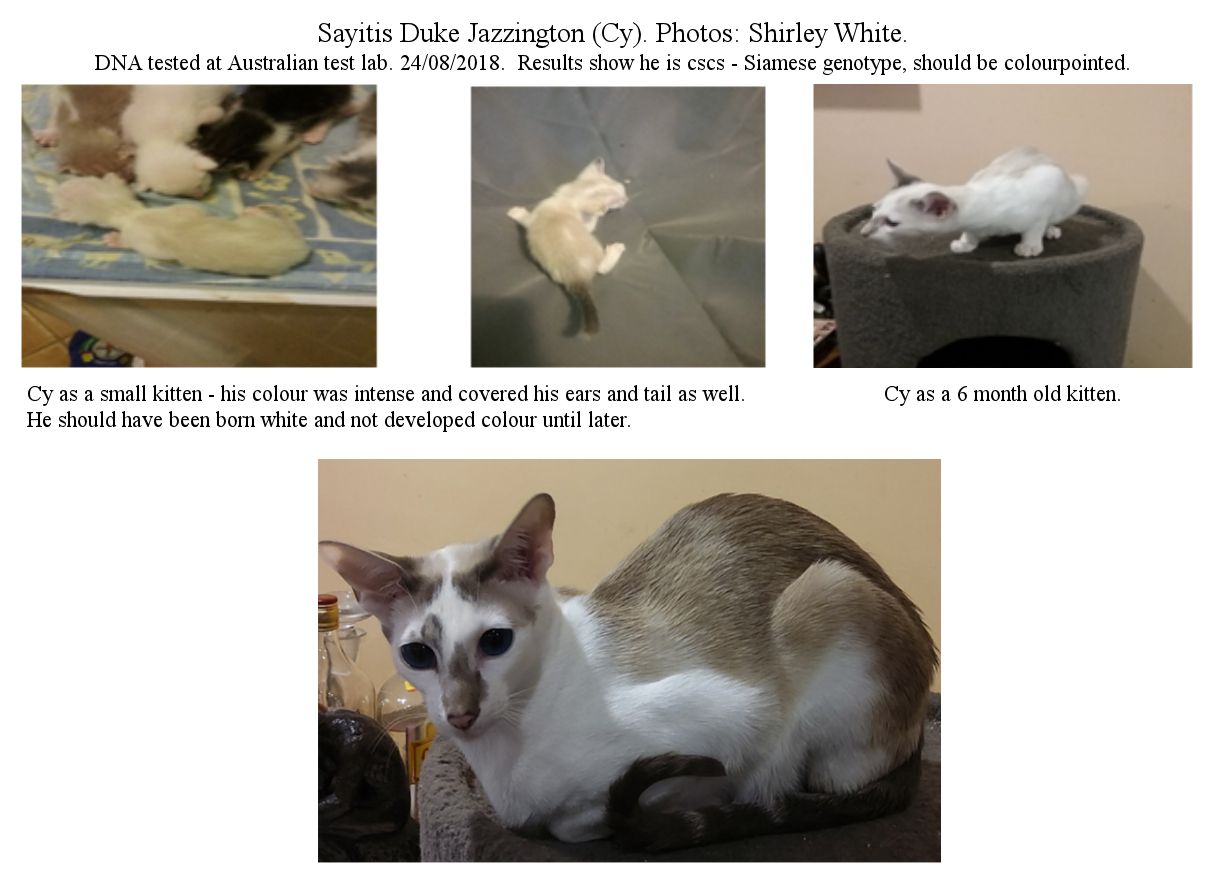
ANOMALOUS COLOURPOINT DEVELOPMENT
Colourpoint (Siamese pattern) cats are born white, because the temperature in the womb prevents pigment from developing. The kittens develop colour as they grow, the pigmentation being darker on the extremities - face, ears, tail and limbs - because those areas re cooler than the torso. As the cat ages, the body becomes darker. The intensity of pigmentation is also affected by the external temperature.
Shirley White examined of the occurrence of a different coat pattern on Sayitis Duke Jazzington ("Cy") and reported on this in January 2020. Cy was born in March 2020 and is genetically cscs (Siamese colourpoint) and dd (homozygous dilution, in his case he is blue).
In 2000, Shirley White acquired Bajimbi Magic Happens (Willow), a chocolate and white Oriental Shorthair (OSH) and Bajimbi To Bi or Not to Bi (Tobi), a chocolate and white bicolour-point (Siamese) Male for breeding. In 2018, her van-pattern OSH female delivered a litter of bicolour kittens, but blue tabby and white colourpoint male kitten Cy was born with colour patches on his body. Colourpoint is a temperature-sensitive mutation. Colourpoint cats should be born white, because the temperature in the uterus inhibits pigmentation, and they develop colour as they grow. Cy had dark ear tips, dark tail and strong cream classic tabby markings on his body, top of his head and backs of his ears. His eyes remained brilliant deep blue. Because Shirley did not know what had happened and did not want to spread unknown mutations, he was neutered. Because she owns Cy's parents, she could repeat the mating. Other Siamese breeders could not explain this either. DNA testing showed Cy was cscs (colouroint) and not mink (cbcs), so he should have been born white.

With no other breeder who had experienced this in their Siamese breeding programs, she re-mated the parents at a similar time of the year to rule out a climate-related variation. The resulting litter was born 7-Feb-2020: 3 kittens, 1 cinnamon ticked bicolour and white, 2 black and white (ticked) bicolour, all females. All went through eye colour change. However, unlike all the ticked tabbies Shirley has bred, one female developed a different coat pattern with light and dark ticked areas and a confused spine line that becomes wide and then narrows. Shirley has bred Abyssinians and this was unlike any ticked tabby she had bred or seen. This female will be mated to a Peterbald stud, whose sire is the same as the grand-sire of the dam and whose colour and pattern genes may help to throw light on what is happening.
Shirley explored the background to the pedigree in case the van pattern - caused by the white spotting gene - had played ricks. She also looked into other colourpoint breeds (Ragdoll, Tonkinese, Snowshoe etc) but found no other breeders whose colourpoint cats were born with visible colourpoints. The only other case was reported by a geneticist in New Zealand who was aware of a similar cat being bred in New Zealand. The next stage is to investigate the pedigree and get a more comprehensive DNA test. The "Optimal Mars Selection Panel" is the recommended test, but is based in Washington, USA and does not accept DNA from outside of North America.
Cy's 10 generation pedigree (bred in Australia) are all Siamese/Oriental Shorthair. Cy's distant pedigree (i.e. back to European and UK-bred ancestors) on the mother's side includes Abyssinian, Burmese, Persian, Chinchilla, American Shorthair and Blue Eyed White Oriental Shorthair. Siamese were used in several breeding programmes, including founding new breeds (e.g. Havana, Himalayan) and some of the "Experimental Shorthair" progeny went back into the Siamese breed, often of necessity (post-war shortage of pure Siamese) or because they looked suitably Siamese in type. The American Shorthair is a red herring because self-colour Orientals imported into the USA in the 1970s for the Havana Brown programme were registered as Domestic Shorthairs, later renamed American Shorthairs as US registries had no category for solid Oriental at the time. These cats were black Foreign (Oriental) Shorthairs. For example, American Shorthair "Black Jack" was actually a Foreign Black (US: Ebony Oriental Shorthair) bred from Solitaire Pine Marten (Ebony Smoke Oriental Shorthair) and Solitaire Tyfyny (Lilac Pt Siamese).
The Russian Blue and British Shorthair are the famous Laurentide cats just after WW2; a Russian Blue was bred to seal point Siamese and the offspring were all registered as British Shorthair (another breed that was in very low numbers due to the war). Some of the offspring were bred to seal point Siamese giving rise to Oriental Shorthair and Siamese offspring. Larentide Brown Prestige was bred to a blue Persian and the offspring were registered as blue Oriental Shorthair, later generations down the line became colourpoint Persians (Himalayans). The Abyssinian would be sorrel male Tranby Red Tutankhamen used in the Southview line; he was bred to a seal point Siamese. Descendants of these cats were self-coloured chestnut Oriental cats and others were colourpointed offspring that went into the Siamese gene pool.